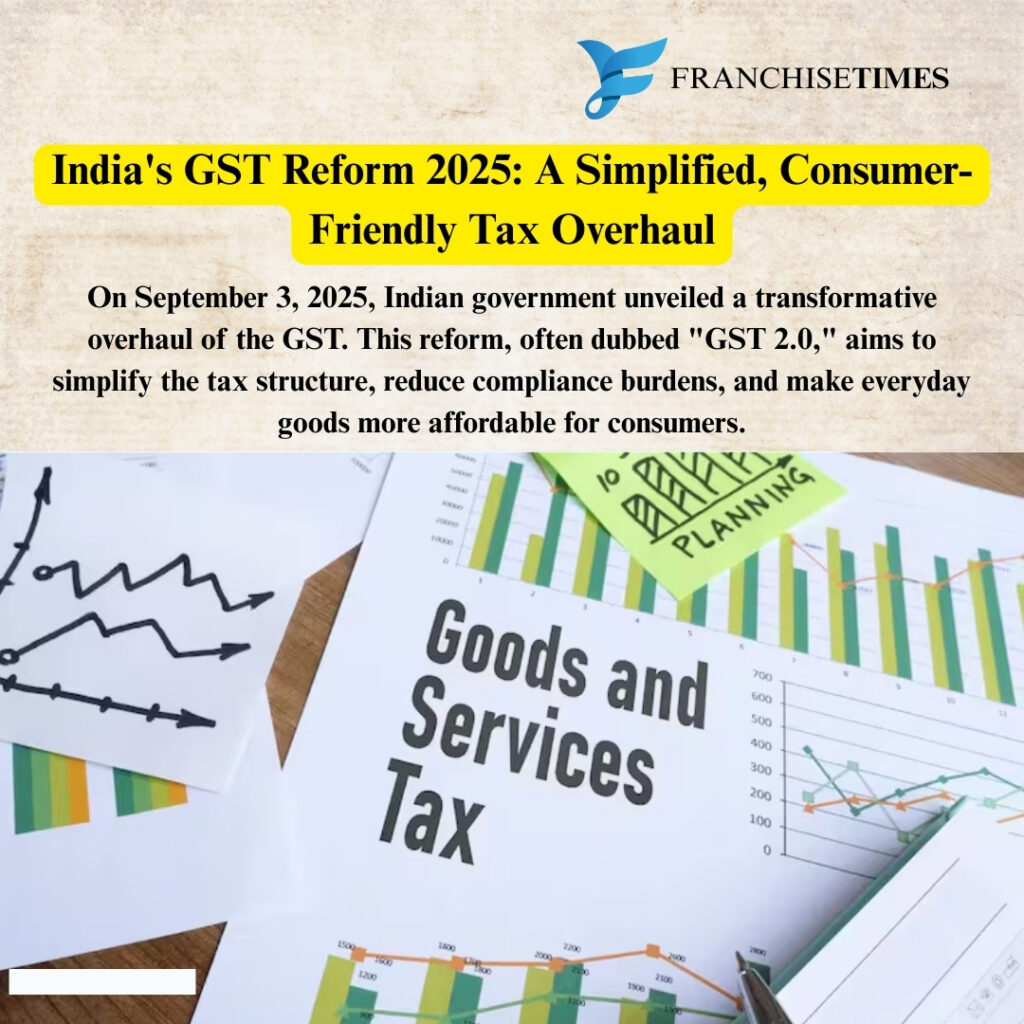🇮🇳 India’s GST Reform 2025: A Simplified, Consumer-Friendly Tax Overhaul
India GST Reform 2025 September 3, the Indian government unveiled a transformative overhaul of the Goods and Services Tax (GST) system. This reform, often dubbed “GST 2.0,” aims to simplify the tax structure, reduce compliance burdens, and make everyday goods more affordable for consumers. Set to take effect on September 22, 2025, the new system introduces a streamlined two-slab GST structure, marking a significant departure from the previous four-tier system.

🔍 Understanding the New GST Structure
The most notable change in the 2025 GST reform is the consolidation of tax slabs. Previously, the GST system had four main slabs: 5%, 12%, 18%, and 28%. Under the new structure, these have been reduced to two primary slabs:
- 5%: Applicable to essential goods and services.
- 18%: Applicable to most other goods and services.
Additionally, a special high rate of 40% has been introduced for “sin goods”—products deemed harmful to health or society, such as tobacco, luxury cars, and aerated beverages. This move aims to discourage consumption of such items while generating additional revenue. The Times of India
🛒 What Gets Cheaper?
The reform brings significant relief to consumers, especially in the middle and lower-income brackets. Several everyday items will see a reduction in tax rates, leading to lower prices:
- Household Essentials: Items like soaps, toothpaste, and Indian breads (roti, naan) will either be tax-free or taxed at 5%, down from 12% or 18%. Press Information Bureau
- Consumer Electronics: Air conditioners, large TVs, dishwashers, and small cars will see their GST reduced from 28% to 18%. The Economic Times
- Healthcare Products: Life-saving medicines and health insurance premiums will be reduced from 12% to 5%, making healthcare more affordable. Press Information Bureau
- Automobiles: Small cars and motorcycles up to 350cc will benefit from reduced GST rates, making them more accessible to consumers. The Times of India
These changes are expected to boost domestic demand, especially ahead of the festive season, and provide a much-needed economic stimulus. Reuters
💸 What Gets Costlier?
While the reform brings relief to many, certain products will see an increase in tax rates:
- Luxury Goods: Items like high-end automobiles, yachts, and helicopters will now attract a 40% GST, up from the previous 28%. The Times of India
- Sin Goods: Products such as tobacco, gutkha, and cigarettes will also fall under the 40% tax bracket, aligning with the government’s objective to discourage their consumption. The Times of India
These adjustments aim to promote healthier lifestyles and reduce the consumption of harmful products.
🏢 Impact on Businesses
The GST 2025 reform is not just consumer-centric; it also offers several benefits to businesses:
- Simplified Compliance: With fewer tax slabs, businesses can expect reduced complexity in tax calculations and filings.
- Improved Refund Mechanism: The new system promises faster and more efficient GST refunds, enhancing cash flow for businesses.
- Boost to Domestic Manufacturing: By reducing taxes on essential goods and consumer durables, the reform encourages domestic production and consumption.
- Enhanced Competitiveness: Lower tax rates on inputs like cement and auto parts can reduce production costs, making Indian products more competitive in the global market. Reuters
📅 Implementation Timeline
The new GST rates will come into effect on September 22, 2025, coinciding with the start of the Navratri festival. This timing is strategic, aiming to maximize the impact during the peak shopping season. Businesses are advised to update their billing systems and inform customers about the upcoming changes to ensure a smooth transition. Press Information Bureau
🔍 Conclusion
India GST Reform 2025 marks a significant step towards a more efficient and consumer-friendly tax system. By simplifying the GST structure and reducing tax rates on essential goods, the government aims to alleviate the financial burden on households and stimulate economic growth. While certain luxury and sin goods will see higher taxes, the overall impact is expected to be positive, fostering a more equitable and prosperous economy.
As the implementation date approaches, both consumers and businesses should stay informed and prepared to adapt to the new GST regime. With these reforms, India is poised to take a significant leap towards a more streamlined and inclusive tax system.
